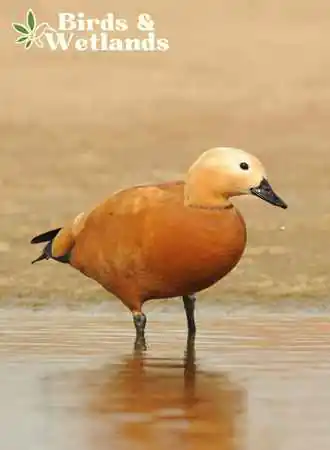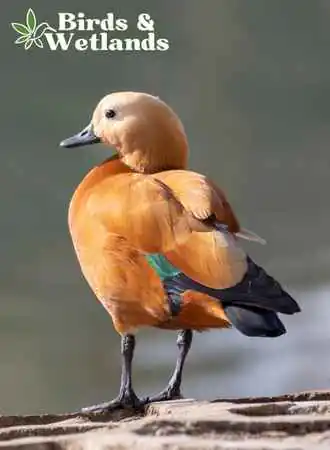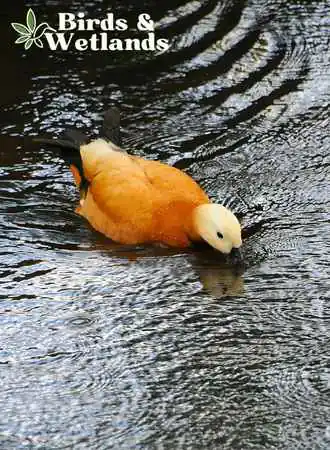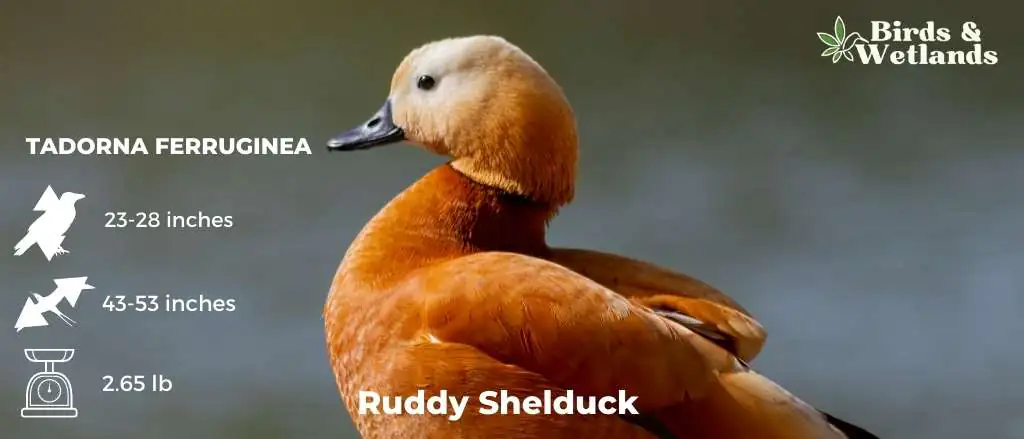The ruddy shelduck (Tadorna ferruginea), also known as the Brahminy duck, is a distinctive waterfowl that breeds in southeastern Europe and Central Asia and wintering in the Indian subcontinent and southern Asia. It got its name from its rusty, orange-brown body plumage and paler head.
The genus name Tadorna means “pied waterfowl” in Celtic.
Scientific Name: Tadorna ferruginea
Height: 58 to 70 cm (23 to 28 in)
Wingspan: 110 to 135 cm (43–53 in)
Weight: 1.2 kg
Ruddy Shelduck Description
The ruddy shelduck is a beautiful bird with rusty orange plumage, black bill, legs and feet, and dark brown eyes. The black rump, undertail-coverts, and tail are the exceptions. The coverts on the wings are white and washed yellowish-orange in fresh plumage.
The primary and secondary flight feathers are black, and the secondaries have green mirrors. The flight feathers on the underwing are black, contrasting with the white coverts.
There are several ways to tell the difference between a male and a female ruddy shelduck. The most obvious is the male wearing a narrow black collar during the breeding season. This collar, however, is only sometimes visible, so it is not a foolproof method.
Another distinguishing feature is the face and head plumage. Males have a yellowish head and neck, while females have a whitish face and a paler head and neck.
Finally, look at the male’s nape, which is darker.
The juvenile ruddy shellduck has duller plumage than the female, with washed greyish-brown plumage, particularly on the head and upper parts.

Listen to Ruddy Shelduck
A ruddy shelduck makes a loud honking call.
Ruddy Shelduck Habitat

The ruddy shelduck is usually seen in pairs or small groups. It rarely forms large flocks, although wintering gatherings on chosen lakes and slow rivers and molting flocks may form.
This duck inhabits inland water bodies such as rivers, reservoirs, and lakes. It avoids wooded and forested areas, but a few ducks live near brackish and saline lagoons. Some birds live on agricultural fields.
Moreover, ruddy shelduck populations rarely venture in high altitude places, instead staying in the lowlands.
In captivity, these ducks houses in a very large area due to their aggressive and anti-social behavior.

Ruddy Shelduck Range
The ruddy shelduck is a bird found in many areas around the world. Their main breeding area is from central Asia, southeast Europe to western China. They are also common in some of the eastern parts of Asia but migrate to other areas during winter.
Their population is declining in the eastern regions of Europe, but they can still be found in southern Spain and other parts of the continent.
In North America, a few ruddy shelducks have been spotted on the eastern coast, but it is uncertain if these ducks were vagrants.
There are very small resident populations in western and north Africa and Ethiopia.
Ruddy Shelduck Diet
Ruddy shelducks are nocturnal omnivores that consume plants and animals. They graze on grasses and other terrestrial plants during the day and feed on aquatic invertebrates and small fish in the water at night. When berries, nuts, and other fruits are available, these ducks will eat them in addition to their regular diet.

Ruddy Shelduck Nesting & Mating Habits
During most of the year, the ruddy shelduck is relatively peaceful but can become quite aggressive during the mating season. It can be very aggressive towards its own kind and other species. The female, in particular, approaches intruders with her head bowed and her neck stretched, making angry calls.
If the intruder persists, the female will return to the male and run around him, tempting him to attack. The male and female may chase the perceived intruder and attack it with their beaks, even striking them with their wings.
Clashing with other ducks and animals can sometimes result in serious injury or even death. While the ruddy shelduck is not a major pest, their aggressive behavior during the breeding season can be a nuisance to other ducks and waterfowl.
Ruddy shelducks mate for life and typically form pairs between the ages of two and three. The ruddy shelduck courtship ritual is simple and usually takes place on the water.
While the male stretches his neck and dips his head, the female raises her tail. If the female is receptive, she will repeatedly extend her neck and dip her head. The couple will mate on the water once they have paired up.
The ruddy shelduck is a cavity-nesting bird that builds its nest in tree holes and burrows. These cavity nests can be in trees, bushes, or ground. The shelduck will line the nest with down and feathers to create a soft place for the eggs to rest.
The female ruddy shelduck lays about eight eggs in creamy-white color and incubates them for about four weeks.
Once the eggs hatch, both parents care for the young, which fledge in fifty-five days.
Ruddy Shelduck Population & Conservation Status
Buddhists consider the ruddy shelduck sacred, with a rising population in central and eastern Asia. However, its European population is in decline due to drying up of large wetlands and hunting pressure.
The total estimated large total population is between 170,000 to 225,000. Although some populations are declining, it is not high enough to be considered threatened. Currently, the conservation status is “Least Concern” assigned by the IUCN (International Union for Conservation of Nature).
Furthermore, this duck is protected under the Agreement on the Conservation of African-Eurasian Migratory Waterbirds (AEWA).

Key Points
- The ruddy shelduck is known in India as the Brahminy duck.
- The ruddy shelduck has rusty orange plumage, a black bill, legs and feet, and dark brown eyes. It has white wing coverts, a whitish head and the tail and the flight feathers are black.
- The male has a black ring at the base of his neck.
- Ruddy shelducks inhabit inland water bodies such as rivers, reservoirs, and lakes. They avoid wooded and forested areas and rarely venture into high-altitude places.
- The ruddy shelduck is a bird found in many areas around the world. Its Asian population is rising while its European population is on the decline.
- The male and female form a lasting pair bond with each other.
- Ruddy shelducks are nocturnal omnivores that eat plants and animals. They also eat berries, nuts, and other fruits.

